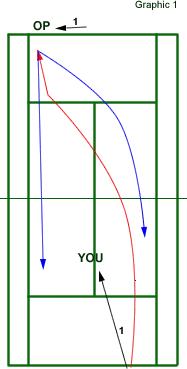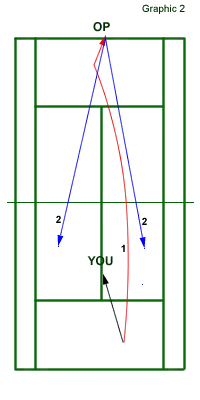Your “survival” at the net depends a lot on how you got there. Transitioning to the net has tremendous importance; based on how you played the transition phase, you could be attacking or defending at the net.
That’s right, only because you are coming up does not mean you are necessarily attacking.
If you came up following a quality approach shot you could call it an attack; otherwise, you are… in trouble.
Your court coverage must depend on the following two attributes:
1. The Type of Approach Shot You Choose
– Slice Approach Shot
Slice is great (if executed properly) because it makes the ball stay low and the under-spin makes it difficult for your opponent to lift the ball too high above the ground. It is extremely hard to get lobbed if you approach with a good slice shot.
Make sure that you do not open the racquet too much when executing a slice so that you do not offer your opponent a nice sitter that he can attack you with.
– Swinging Volley
This usually happens when you get your opponent off the court with an aggressive angled groundstroke and you sense that he will be reaching for the ball in an attempt to just get it back in play. If you have a good sense of recognizing when your opponent is in “trouble” you will step inside the baseline and take the ball in the air depriving your opponent of time to cover the court.
– Topspin Approach Shot
This type of approach is somehow risky because the topspin makes the ball bounce higher which will give your opponent a nice look at your feet or at least he can make you hit a low volley by directing the ball low.
The topspin approach shot must be done to the open court and aggressive so that your opponent will not be in a balanced position of execution.
2. The Angle You Send the Approach Shot To
– Cross-Court
If you hit your approach shot cross-court you better make sure it is an aggressive one, otherwise, you expose a lot of court for a passing shot from your opponent (see graphic 1 below)

The ideal spin would be slice because it will make it hard for your opponent to pass you down-the-line due to the higher net closer to the sideline.
Your position on the court should be on the same side as the ball (covering the fastest ball’s route which is the down-the-line); that means you will have to cross on the other side-half of the court (over the center line). That could take more time for you to get set and in balance (see graphic 1).
If I were in this situation (approaching behind a cross-court shot) I would be more careful about an eventual cross-court passing shot attempt from my opponent. Why cross-court passing? Because the ball travels over the lowest part of the net and your opponent will not have to run too much to retrieve the next shot (see Court Coverage – Playing at the Baseline vs. Your Opponent at the Net).
– Down-the-Middle
It is a good option to go for considering that you close the angles for your opponent. The type of spin would not matter too much even though I would favor slice only because it makes it difficult for your opponent to lob or hit the ball at your feet.
Position yourself about halfway between the possible angles that your opponent could send the ball, which is somewhere around the center line (see graphic 2 below).

– Down-the-Line
Arguably the best option for approaching the net is for the following reasons: your movement toward the net is made behind the trajectory of the outgoing ball, you do not have to cross over to the other side half and as a result, your body is in balance and moving forward.
Your position on the court at the moment you split step should be on the same side-half with the ball (see graphic 3 below) which has the following advantages:
a. if your opponent tries to pass you down-the-line (which is the fastest shot that your opponent can pass you with) you will be close to it.
b. if he tries to hit cross-court, with a couple of side and forward steps you can cut the angle, especially with the longer distance that the ball travels cross-court will give you more time to intercept such a shot.

Regarding the spin choice for the down-the-line approach, again, I would recommend the slice for the same reasons I mentioned before.
In summary, when playing at the net against an opponent at the baseline, consider the quality of your approach shot which should be a low and deep slice shot (gives you more time to set up at the net), and as far as your positioning inside the service court should be on the same side-half with the ball (and your opponent who is about to strike it).
One more thought regarding the split step: this should be a matter of when you do it, not where you do it. The split step should be done just before your opponent strikes the ball – anywhere between the ball bounce (on the opposite side) and the opponent’s contact with the ball.